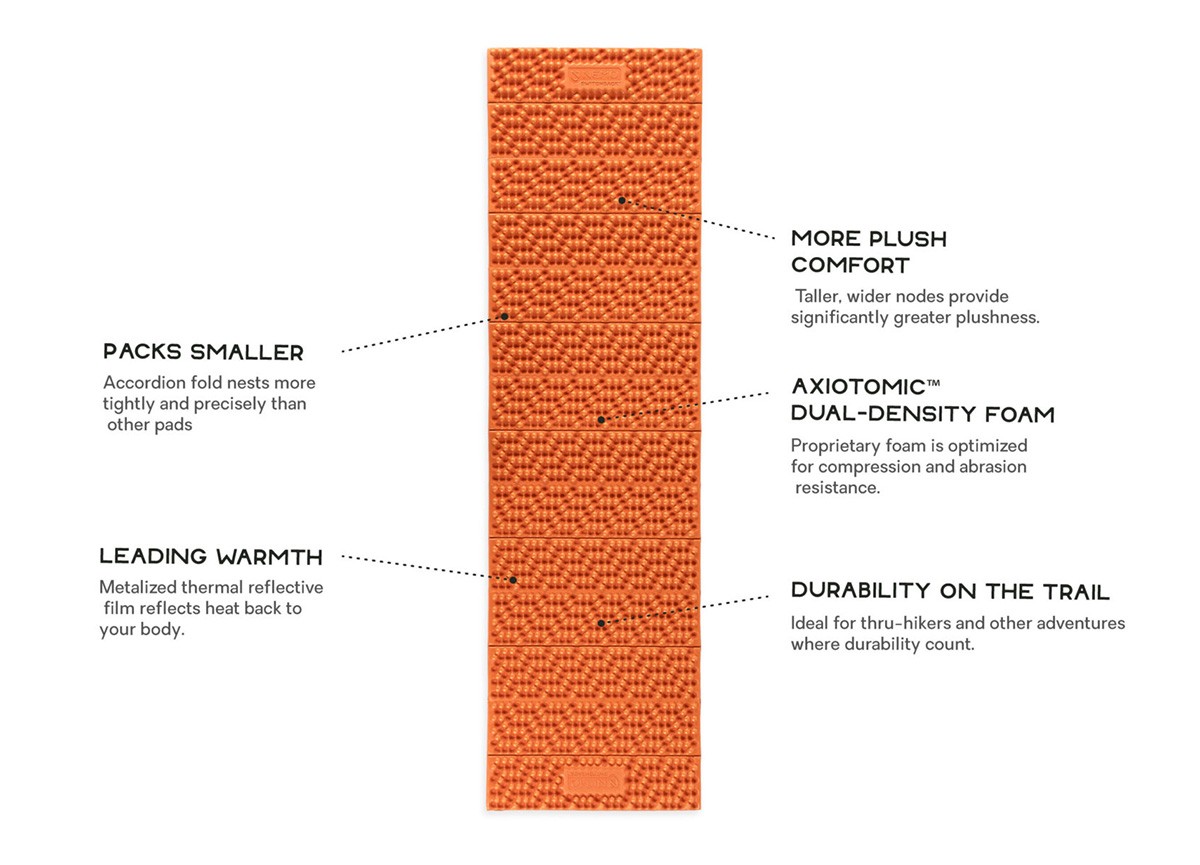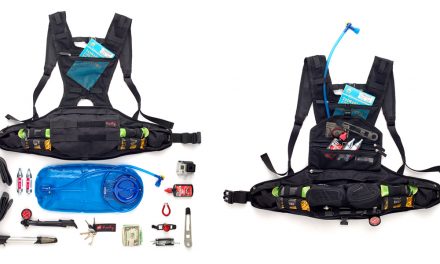Junior designer Nemo gives the concertina mat a makeover, catching inventor Thermarest napping.
NEMO Equipment Inc. is a company based in Dover (New Hampshire, USA) that designs and manufactures outdoor equipment, tents, and shelters. NEMO was founded by Cam Brensinger in 2002 while studying industrial design at the Rhode Island School of Design.
The name – New England Mountain Equipment – is a tribute to their New England roots and a nod to Jules Verne’s Captain Nemo. In their short corporate life, NEMO has won numerous awards and accolades for their innovative designs.
Product Overview: The mat is made from closed cell cross-linked polyethylene foam, moulded in a concertina format to fold into a rectangular block. The rectangular mat readily lays out flat, where it looks like a giant quail egg carton. NEMO’s Switchback is a cheeky iteration of the genre-defining Thermarest Z Lite Sol which emerged in 2012 as the first innovative closed-cell foam mat design. It’s unclear whether Thermarest is thrilled at this tribute or miffed that they didn’t update their model earlier. While NEMOs version is about the same weight, it folds to be more compact, is deeper, and is a better colour.
History Lesson: Closed-cell foam (CCF) mats are the original portable bushwalking sleep mattresses. Closed cells differ from open cells in that they are sealed and therefore don’t absorb water like foam sponges. These mats are lightweight and provide a degree of comfort, but they are somewhat bulky. In recent years CCF mats have been mainly surpassed by the rapid development in inflatable mats which offer good insulation and superior comfort, albeit with the risk of puncture. Inflatable mats are severely limited in their performance and comfort if they puncture or experience valve failure.
CCF mats are used today by adventure racers, alpinists, winter campers and budget-conscious bushwalkers.
CCF mats are inherently reliable and can be used even when damaged or torn. I still have a 40-year-old Karrimat – badly damaged by my dog 35 years ago which functions as effectively as when it was new. The same cannot be said for inflatable mats. I’ve had a lightweight inflatable Klymit Static V mat explode when I left it inflated inside a tent, while I went for a day walk. Earlier this year my Thermarest Prolite self inflating mat succumbed to a Scoparia puncture in Tasmania, which necessitated resuscitation 3 or 4 times a night. Unlike inflatables, CCF mats offer the same reliable performance day in, day out.
Product details. Switchback is a dimpled, three-layer mat. The upper layer is a soft orange foam joined to a light grey mid-layer foam which is then capped on the bottom with a silver-coloured metalized film. The dual-density foam layers provide a mixture of support, initial comfort and spring recovery or memory. The metal layer offers reflective insulation and will help prevent thorn and abrasion damage on that side.
Hexagonal nodes: Switchback’s mat dimples are taller than its parent design with an improved rib structure at the base to resist bottoming out. These nodes mate closely with the negative space on the upper side to provide a more compact folded configuration. NEMO has applied for a patent for this node design.
Reflective Film: NEMO has applied a thin metallic film to one side of the pad. In winter I would expect the mat to be used with the reflective side up to return heat back to the body, and in summer silver side down for a cooler sleep. NEMO, however, suggests using the reflective side down “to protect you from the cold ground” which seems to suggest a lack of understanding of thermal transfer principles on their part.
R-value: is a measure of how well a two-dimensional barrier resists the conductive flow of heat. It is an important measure of how well a mat will prevent your body warmth leaking through to the ground.
Surprisingly NEMO does not say what the R-value is of this mat, simply that it is good for -7 deg C. It’s unclear how this figure was obtained. NOTE: Nemo now lists the R-value as 2 (on this page under the Tech Specs section).
While the mat is 22mm tall, the actual foam wall thickness is only 4mm due to the egg carton design.
Thermarest claims R 2.6 for their model and I would expect NEMO’s R rating to be similar. As R values are additive, winter campers often supplement their inflatable mat with a CCF mat on the bottom.
Size: the mat is 52cm wide by 179cm long. This is equivalent to a tad under 5’ 11” long in the old money. Shorter users can fold up a panel or two into a headrest. Packed size is 52 x 13 x 13 cm, while more compact than other CCF mats, it’s still likely to be the biggest item in your pack.
Weight: NEMO claim the mat weighs 415 grams, and I was pleased that that was exactly what I got on my digital scales with several weighings. NEMO calls it Ultralight, but there are at least five full-size inflatable mats that come in under this weight. NEMO also offer a short version at 130 cm and 300 grams.
CCF mats can also be easily modified such as shortening to save weight or to fit specific applications like hammock sleeping or as a frame for a frameless pack. A pair of scissors is all it needs.
Colour: Switchback comes in one colour: pumpkin orange with a silver alternate side (someone is clearly a fan of Donald Trump). I like to have some brightly coloured items in my kit, in case I need to attract attention, so I’m okay with this. The distinctive recognisable product colour will also immediately alert softer inflatable users to the fact that you are a rugged, performance-oriented individual if you are into that sort of thing.

What about real world performance?
I took the NEMO Switchback on a recent 3 day bushwalk around Mt Bogong as my only mat.
- 1st I slept in the back of my car. Maybe it was the long drive, but I needed to be woken up by my bushwalking companion in the morning to start the walk. I slept on my back and it was a good night’s sleep .
- 2nd night was down on a riverbank with hard, compacted ground. I was sharing a tent with a bloke who is intolerant of snorers. I don’t snore when I’m on my side, so I spent a somewhat uncomfortable night side sleeping, rotisserie flipping over onto alternate hips multiple times. This mat is not good for side sleepers.
- 3rd night was high up on on a spongy alpine herbfield which significantly supplemented the cushioning. This was a restful night, a mixture of side sleeping and back sleeping. I may have let a few snores slip out, but my companion graciously let it go. The temperature was about 2 deg C and I was warm enough.
The first thing I noticed about this mat it the quick setup – just lay it out on the floor in the tent. That’s it. There’s no spring-back tendency to curl back up like rolled CCF mats. No huffing, no pumps or inflater bags or valves to fiddle with. No deflation issues either, in the morning just scoop it up and stash it away. The Klymit mat I had needed a least 5 minutes to squeeze all the air out of it.
The pad is bulky- it has a packed volume of 9.2 litres. Fortunately, I managed it to fit inside my Osprey Exos 48 pack without drama. Due to their size, CCF mats are usually carried externally and are readily eroded by any rocks or scrub they touch (if it won’t fit inside your bag, try to carry it vertically to avoid leaving a trail of foam breadcrumbs in the bush).
Warranty: NEMO Equipment offers a lifetime warranty on all their products. In the first instance, they refer you back to your retailer, then directly to themselves.
But is it comfortable? If you are looking for a comfortable sleeping mat then NEMO Switchback is not for you. Look instead at inflatables. Switchback is about lightweight, reliable, no-fuss performance. Comfort is the least of its attributes. It is more comfortable than a ten-dollar yoga mat, which in turn is more comfortable than sleeping directly on the ground. If you can take comfort out of your consideration, then Switchback is a category winner.
Think of Switchback as the Suzuki Jimny of the 4WD world-surprisingly capable and functional – with the ability to outperform much flashier, more luxurious and more expensive contenders. But you mightn’t want to drive a long way in it.
Anything missing? Due to the damage, we now know that microplastics cause to the environment, the fact that this product will be used in wilderness environments, and that it will most likely be carried externally to a rucksack, a stow sack or carry bag would be a sensible inclusion.
Design, Comfort & Durability (Rating: 70%)
Take away the Comfort aspect, and this score would be 95%.
Functionality & Ease of Use (Rating: 95%)
Switchback has limited product specifications (R-value, usage instructions), neither of which will deter the hardcore potential user base.
What I Like
- Works all the time, every time. Reliable. Durable. Failsafe.
- Cheaper than similar weight inflatables. Doubles as a sit pad.
- Immediately identifies the owner as a rugged, heavy duty outdoor adventurer.
What I Don’t Like
- Can be susceptible to abrasion damage.
- No R-value published.
Get One
The Nemo Switchback is available online from Wildfire Sports.
Have you tried the Nemo Switchback Ultralight Sleeping Pad? Got any questions or comments? Let us know by commenting below.






Interesting and thorough review, thanks. I have wondered about trying one of these mats but as I’m a side sleeper – i now know I’m sticking with my inflatable!
Cheers
Robin